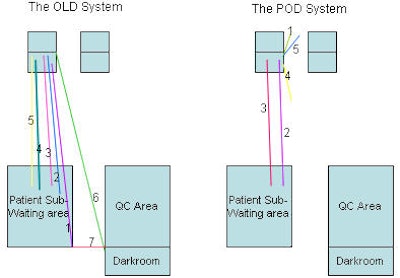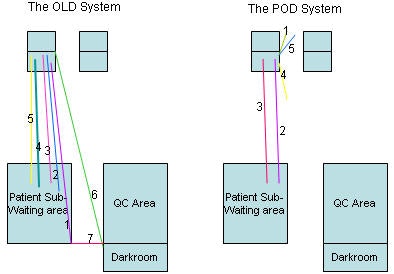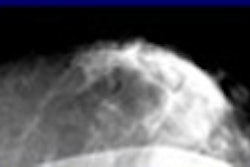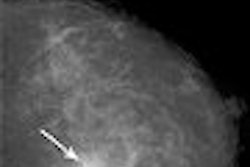
By becoming "pod" people, breast imaging professionals at the Mayo Clinic in Rochester, MN, have increased their productivity while streamlining their workload. But such efficiency wasn't always the case at this high-volume screening mammography center.
"We were trying to find a more efficient way to run our breast imaging department," explained Carol Mount, during a discussion of her group's 2005 RSNA poster presentation in Chicago. "The first thing we did was a time study."
Mount is the supervisor for breast imaging and intervention at the Mayo Clinic. The breast imaging department consists of 13 film-screen mammography rooms, four ultrasound suites, and two rooms for interventional procedures. There are 19 full- and part-time radiologic technologists (RTs) and four assistants.
Under the old system, assistants checked in the patient and prepared her for the exam. The technologist then performed the exam, including obtaining patient history, and brought the paperwork and cassettes to the darkroom, before returning to scan another patient. The support staff processed the film, which was then checked by the quality assurance (QA) technologist.
Based on the results of the time analysis, Mount's group found that it took the RTs six minutes to obtain patient history and about four minutes to perform a standard, four-view mammogram. Yet the total exam time per patient was averaging 25 minutes, leaving 15 minutes of time unaccounted for. The solution to this problem was to optimize the technologists' time as well as how the exam rooms were utilized.
The first change was to have the patients fill out their history forms while sitting in the waiting room. The patient then handed the completed form to the RT before the exam, who would then go over key questions with the woman, but not review the entire form. This whittled down the RT-patient interaction time by about six minutes.
Another time-saver was to have assistants, rather than the RT, escort the patient into the new, four-room pod configuration (see graphic below). The assistants' other duties were to bring paperwork and unexposed cassettes to the pod and to take finished paperwork and exposed cassettes to the darkroom. This resulted in a steady flow of traffic in and out of the department.
 |
| Image courtesy of Carol Mount. |
Mount told AuntMinnie.com that hiring these assistants did not place an additional financial burden on her department as they were already Mayo clinic employees whose responsibilities were shifted over from the film library. In addition, this entry-level position did not require special training or certification, she said.
Under the new system, the in-between exam time was cut down from 15 minutes to 7.5 minutes. The time to review the patient's personal history dipped from six minutes to about a minute. The extra time created to scan patients came in at 12.5 minutes.
Before implementing this new system, Mount's group asked the RTs to set a goal of screening 15 patients per day -- a goal that they managed to exceed. "With the pod system in place, a technologist is able to perform an average of 26 mammograms per day," Mount said. Over time, the department has seen a 45% increase in the number of patients scanned per day.
While this new system is in place for screening mammograms only, RTs who also perform diagnostic exams found that they had more time to spend with those patients, the authors stated. Other benefits of the new system included a shorter exam time for patients and more personal time off for RTs who were getting their work done faster. Finally, the RTs reported that they were less tired at the end of each work day.
By Shalmali Pal
AuntMinnie.com staff writer
December 21, 2005
Related Reading
Homegrown tool improves radiologists' workflow, December 16, 2005
Hitting the ceiling over HIPAA-required walls, December 6, 2005
Personalized training of mammo decision support tool unnecessary, December 1, 2005
Making RVU-based productivity assessment work for you, October 29, 2004
Copyright © 2005 AuntMinnie.com



















